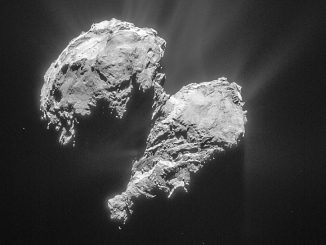
The Philae lander of the European Space Agency’s Rosetta mission captured this view during its first bounce after hitting the surface of comet 67P/Churyumov-Gerasimenko on 12 November 2014, with blurring as a result of the lander’s own motion. The lander was descending at about 3.2 kilometres per hour (2 mph) when it first touched the surface, and its first bounce lasted almost two hours and carried it about one kilometre (0.6 miles) both aloft and downrange. The image from the lander’s CIVA camera is the first view from Philae after its initial touchdown.



